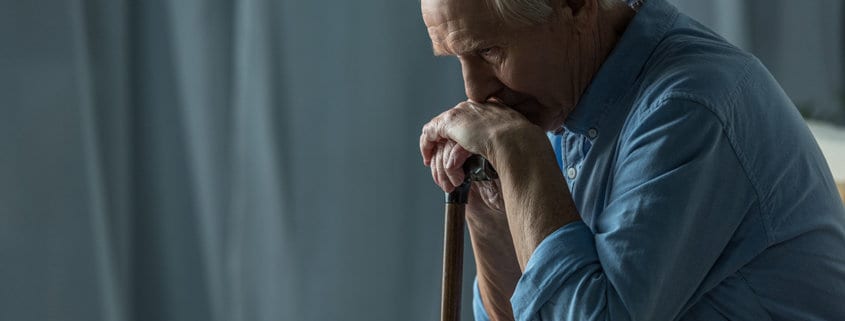Holiday Depression and Seasonal Affective Disorder is a Painful Reality for Many Seniors (Part 1)
For many, the holidays and winter months are the time of year for family get-togethers, traditions, friends, and fun. But this isn’t always the case, and for a large number of seniors Holiday Depression and Seasonal Affective Disorder are a painful reality. The causes for each can be numerous — both psychological and physiological — and often they present similarly. However, considering the more insidious nature of the latter, it’s important that caregivers know what to look out for, and the different factors that can play a role in their onset.
Spotting the Signs of Holiday Depression
The key to any effective individual care plan is in simply knowing your residents. Familiarity with their personalities and ‘baseline’ behaviors, disposition, and temperament are crucial in detecting any kind of change.
The following are typical depressive symptoms presenting in an elderly resident around the holidays:
- Subdued or irritable mood; sadness
- Fatigue, or difficulty sleeping
- Anxiety
- Loss of interest in daily activities
- Change in appetite
- Lack of attention to personal care, hygiene
Unlike other forms of depression, the Holiday Blues are situationally dependent. They begin in the lead up to the holidays, and fade in their wake. Rather than being physiological in origin — the individuals personal biology and brain chemistry — they are based in psychology and sadness. Sometimes, the thing triggers one’s holiday depression isn’t current. Instead, the holidays might dredge up trauma of some kind from a person’s past.
Even if your residents already present some of these symptoms, it’s important to note if they become more severe or if additional symptoms arise. If you notice the symptoms worsening, or if they continue beyond the holidays, this is very likely indicative of a more insidious form of depression.
Seasonal Affective Disorder
Seasonal Affective Disorder is a type of depression whose onset is triggered by changes in seasons. The most common form of SAD occurs in fall through winter, but there are some cases in which the condition affects an individual in the spring/summer months (sometimes referred to as Reverse SAD).
In both cases, there is marked change in mood and disposition, which start out mildly when the season is in its initial stages, but become more severe as the season progresses. Considering it can be easily confused with the Holiday Blues, we’re going to focus on the fall/winter end of the spectrum.
The fall/winter manifestation of SAD resembles the more classic symptoms of depression. Here’s what to look out for:
- Irritability, trouble getting along with others
- Fatigue, lethargy, low energy
- Emotionally hypersensitive
- Change in appetite, especially craving for high carbohydrate foods
- Oversleeping
People who live in regions with distinctive weather changes or where sunlight can be very limited are more likely to develop symptoms SAD. However, even in places like California, where the weather may not change as dramatically, the cooler temperatures can prevent more frequent visits outside, especially for elderly residents, and thereby makes for less exposure to the ever important sunlight.
For individuals with Fall/Winter SAD, symptoms persist for more than two weeks. The reduced sun exposure can lead result in deficiencies or imbalances in the body. For example, serotonin production drops with a lack of sunlight, and this chemical imbalance causes an individual to feel depressed. The cravings for high carbohydrate foods are the body’s way of attempting to increase serotonin levels. Vitamin D also plays an important role in our health, including supporting bone health, preventatives with certain cancers & conditions, as well as help with incontinence. However, Vitamin D is also found naturally in certain foods and also via dietary supplements. Sleep patterns can also be thrown off as well, since the body’s circadian rhythms depend on regular sun exposure. The disrupted sleep prevents the resident from getting quality rest, which can result in depressive symptoms.
Making the Call
While nurses and caretakers play a critical role in determining whether a resident is suffering for Holiday Depression or Seasonal Affective Disorder — considering the frequency with which they might interact with an individual — the ultimate determination must come from the resident’s attending or personal psychiatrist/psychologist.
Psychiatric professionals should determine the best course of treatment, depending on the individual’s needs, cognitive capabilities, and severity of symptoms. Even if the resident is already receiving specific treatment from their psychiatrist/psychologist, it is vital that team members keep all doctors, therapists, dieticians, and other caretakers abreast of any adjustments to the resident’s routines, medical or otherwise. This will help maintain the consistency and effectiveness of the resident’s treatment and care.
In our next article (Part 2 of this series), we’ll take a look at how you as a caretaker can help the seniors in your charge throughout the fall and winter months. While you might not be able to hold the effects of the Holiday Blues or SAD at bay, you can at the very least take steps make their days warmer, merrier, and bright.
—
Assisted Living Education is the leading provider of RCFE certification classes, licensing, products and services for assisted living. Our teachers are industry professionals with many years of experience that are engaging, entertaining and highly informative.



